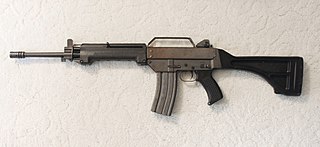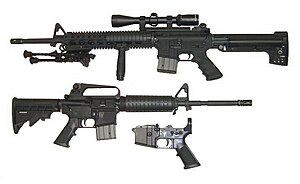
In firearms terminology, an action is the functional mechanism of a breech-loading firearm that handles the ammunition cartridges, or the method by which that mechanism works. Actions are technically not present on muzzleloaders, as all those are single-shot firearms with a closed off breech with the powder and projectile manually loaded from the muzzle. Instead, the muzzleloader ignition mechanism is referred to as the lock.

The Colt AR-15 is a lightweight, magazine-fed, gas-operated semi-automatic rifle. It is a semi-automatic version of the M16 rifle sold for the civilian and law enforcement markets in the United States. The AR in AR-15 stands for ArmaLite rifle, after the company that developed it in the 1950s. Colt's Manufacturing Company currently owns the AR-15 trademark, which is used exclusively for its line of semi-automatic AR-15 rifles.

Direct impingement is a type of gas operation for a firearm that utilizes gas from a fired cartridge to impart force on the bolt carrier or slide assembly to cycle the action. Firearms using direct impingement are theoretically lighter, more accurate, and less expensive than firearms using cleaner and cooler gas piston systems.

A magazine is an ammunition storage and feeding device for a repeating firearm, either integral within the gun or externally attached. The magazine functions by holding several cartridges within itself and sequentially pushing each one into a position where it may be readily loaded into the barrel chamber by the firearm's moving action. The detachable magazine is sometimes colloquially referred to as a "clip", although this is technically inaccurate since a clip is actually an accessory device used to help load ammunition into a magazine.

The ArmaLite AR-15 is a select-fire, gas-operated, air-cooled, magazine-fed rifle manufactured in the United States between 1959 and 1964. Designed by American gun manufacturer ArmaLite in 1956, it was based on its AR-10 rifle. The ArmaLite AR-15 was designed to be a lightweight rifle and to fire a new high-velocity, lightweight, small-caliber cartridge to allow infantrymen to carry more ammunition.

The Colt Automatic Rifle-15 or CAR-15 is a family of M16 rifle–based firearms marketed by Colt in the 1960s and early 1970s. However, the term "CAR-15" is most commonly associated with the Colt Commando ; these select-fire carbines have ultrashort 10.5-inch (270 mm) and 11.5-inch (290 mm) barrels with over-sized flash suppressors.

The ArmaLite AR-10 is a 7.62×51mm NATO battle rifle designed by Eugene Stoner in the late 1950s and manufactured by ArmaLite. When first introduced in 1956, the AR-10 used an innovative combination of a straight-line barrel/stock design with phenolic composite, a new patent-filed gas-operated bolt and carrier system and forged alloy parts resulting in a small arm significantly easier to control in automatic fire and over 1 lb (0.45 kg) lighter than other infantry rifles of the day. Over its production life, the original AR-10 was built in relatively small numbers, with fewer than 10,000 rifles assembled. However, the ArmaLite AR-10 would become the progenitor for a wide range of firearms.
The ArmaLite AR-18 is a gas-operated assault rifle chambered for 5.56×45mm NATO ammunition. The AR-18 was designed at ArmaLite in California by Arthur Miller, Eugene Stoner, George Sullivan, and Charles Dorchester in 1963 as an alternative to the Colt AR-15 design, a variant of which had just been selected by the U.S. military as the M16. A semi-automatic version known as the AR-180 was later produced for the civilian market. While the AR-18 was never adopted as the standard service rifle of any nation, its production license was sold to companies in Japan and the United Kingdom, and it is said to have influenced many later weapons such as the British SA80, the Singaporean SAR-80 and SR-88, the American Adaptive Combat Rifle, the Belgian FN F2000, the Japanese Howa Type 89 and the German Heckler and Koch G36.
The Ruger 10/22 is a series of semi-automatic rifles produced by American firearm manufacturer Sturm, Ruger & Co., chambered for the .22 Long Rifle rimfire cartridge. It uses a patented 10-round rotary magazine, though higher capacity box magazines are also available. The standard carbine version of the Ruger 10/22 has been in production continuously since 1964, making it one of the most successful rimfire rifle designs in history, with numerous third party manufacturers making parts and accessories for upgrading and customization. The 10/22's aftermarket is so prolific that a complete 10/22 can be built without using any Ruger-made components.

Eugene Morrison Stoner was an American machinist and firearms designer who is most associated with the development of the ArmaLite AR-15 rifle that was redesigned and modified by Colt's Patent Firearm Company for the United States military as the M16 rifle.

The Bushmaster XM-15 series is a line of AR-15 style semi-automatic rifles and carbines manufactured by Bushmaster Firearms International, LLC. Variants include the Bushmaster M4-type Carbine, Patrolman series, QRC series, Bushmaster XM15-E2S, and the Carbon 15 line.

The Leader T2 MK5 Series firearms were chambered for the 5.56×45mm NATO cartridge and manufactured by Leader Dynamics of Smithfield, NSW, Australia (1978-1982/1983). The Leader was the brainchild of British weapons designer Charles St. George. It was originally a contender for a 5.56 mm Australian military service rifle to replace the then-issued Lithgow L1A1-F1 SLR and Colt M16A1 rifles. What was unique about this endeavor was that Australia had never designed or manufactured its own commercial gas-operated semi-automatic rifle. The rifle was abandoned when the Steyr AUG was adopted for use by the Australian military.
The Colt Automatic Rifle or Colt Light Machine Gun is a 5.56 mm NATO, open-bolt, full-automatic-only firearm developed by Colt Defense. It is based on the M16A2/A4, and has a distinctive squared-off handguard, vertical grip, carrying handle and integrated bipod.

The ArmaLite AR-7 Explorer is a semi-automatic firearm in .22 Long Rifle caliber, developed in 1959 from the AR-5 that was adopted by the U.S. Air Force as a pilot and aircrew survival weapon. The AR-7 was adopted and modified by the Israeli Air Force as an aircrew survival weapon in the 1980s.

ArmaLite, or Armalite, is an American small arms engineering company, formed in the early 1950s, in Hollywood, California. Many of its products, as conceived by chief designer Eugene Stoner, relied on unique foam-filled fiberglass butt/stock furniture, and a composite barrel using a steel liner inside an aluminum sleeve, including the iconic AR-15/M16 family. While the original ArmaLite ceased business in the 1980s, the brand was revived in 1996, by Mark Westrom.

The Smith & Wesson M&P15 is an AR-15 style semi-automatic rifle by gun manufacturer Smith & Wesson. Introduced in 2006, the firearm is designed for police use and consumer markets.

The Smith & Wesson M&P15-22 is a .22 LR variant of the Smith & Wesson M&P15 semi-automatic rifle, but is blowback-operated rather than direct impingement-operated. It is intended for recreational shooting ("plinking") and small game hunting. It is made with a polymer upper and lower receiver rather than the aluminum alloy that is normally used in AR-15 style rifles, and uses proprietary polymer box magazines.

The SIG MCX is a family of firearms designed and manufactured by SIG Sauer, produced in both selective fire and semi-automatic only models, and features a short-stroke gas piston system, which is inherited from the earlier SIG MPX submachine gun. The MCX is available in rifle, carbine, short-barreled rifle, and pistol configurations. The rifle was further developed into the SIG MCX Spear, which was adopted in its .277 Fury chambering as the XM7 by the U.S. Army in 2022.

An AR-15 style pistol is a handgun assembled using an AR-15 style receiver with suitable parts to create a pistol held and fired with one hand.





















